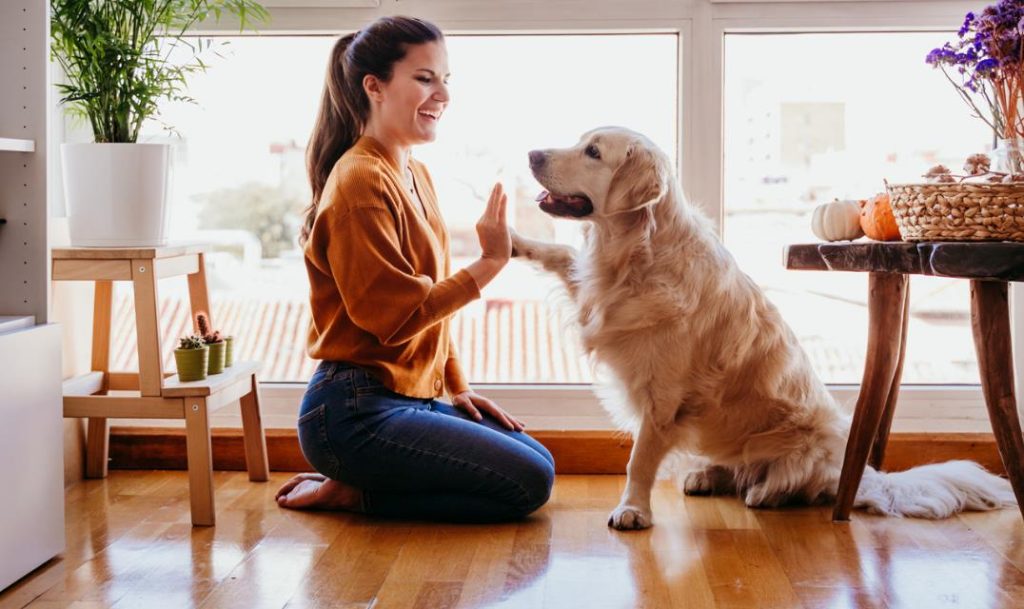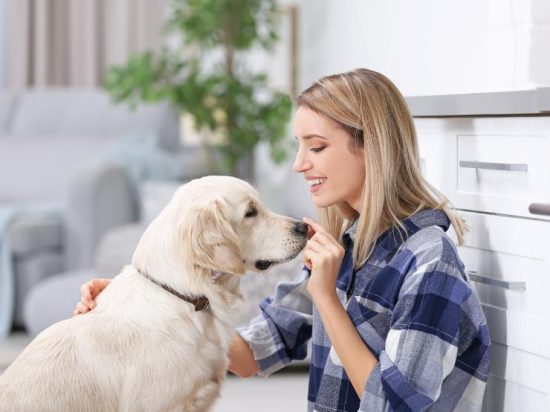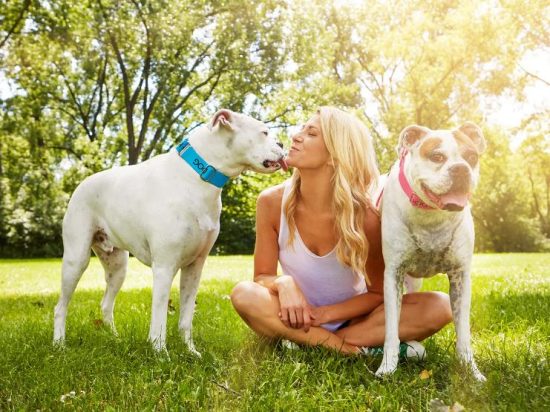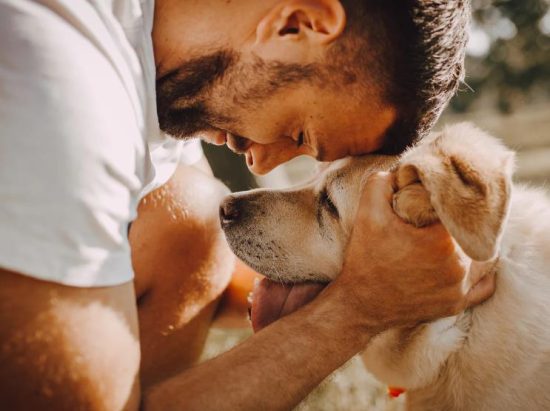Why Does My Dog Stare at Me? Reasons Behind the Gaze
Why does my dog stare at me? Discover the fascinating reasons behind a dog’s intense gaze, from seeking attention and expressing affection to sensing emotions.

Did you know that dogs have been our loyal companions for over 10,000 years? During this time, they have become master observers of human behavior. When your dog stares at you, they are using their eyes to communicate something. It’s up to us to figure out what that something is and respond accordingly.
Dogs stare at their owners for various reasons, such as trying to understand their habits, body language, and emotions, communicating their own needs and feelings, seeking attention or affection, expressing confusion, or even indicating potential health or behavioral concerns. Understanding the meaning behind a dog’s intense gaze can help strengthen the bond between the owner and their canine companion.
Dogs Are Reading Us

Dogs are more in tune with humans than almost any other animal on earth. They can sense our moods, follow our pointing gestures, and read us for information about what’s going to happen next. Dogs stare at their owners to learn about their environment and anticipate their actions. Dogs have an uncanny ability to detect our emotional states. They can detect subtle changes in our body language, facial expressions, and tone of voice that indicate how we are feeling. This allows them to adjust their behavior accordingly, whether offering comfort when we’re sad or matching our enthusiasm when we’re excited.
Dogs are masters at interpreting our nonverbal cues, including how we point or gesture. They quickly learn to associate these movements with specific objects or actions, using the information to understand their surroundings better and anticipate what might happen next. This skill helps dogs navigate their environment and respond appropriately to their owners’ needs.
Dogs can read small details that signal upcoming events or activities. They learn to recognize cues like the sound of keys jingling or the feel of a leash being picked up, and they stare intently at their owners, eagerly awaiting the next step. This ability to anticipate our actions makes dogs better prepared and more responsive, strengthening the bond between pet and owner.
Dogs Are Trying to Tell Us Something
Staring also occurs when a dog is trying to get its owner’s attention or communicate a specific need. For example, if it’s time for a potty break, the dog might sit by the door and stare at its owner, indicating its need to go outside. This type of staring behavior is the dog’s way of telling its owner that it needs a potty break.
Similarly, if the dog is hungry and the owner is eating, the dog’s staring can signal their desire for a share of the meal. This staring behavior is the dog’s way of communicating their hunger and begging for a bite of the owner’s food.
Some dogs even use staring to manipulate their owners and get what they want, such as [why dogs stare when they want attention] begging for food at the dinner table. However, owners should be aware of this behavior and avoid rewarding it, as it can reinforce the unwanted staring. Instead, owners should teach their dogs alternative ways to communicate their needs, such as ringing a bell to signal a need to go outside.
Why Does My Dog Stare at Me?
A dog’s stare can also express emotions, both positive and negative. In the wild, staring is considered a threatening and rude behavior among wolves, and some dogs still retain this attitude. A hard, unblinking stare accompanied by a stiff posture can indicate aggression, often associated with resource guarding. On the other hand, a loving stare with slightly squinted eyes is a way for dogs to express affection. This type of mutual gaze between humans and dogs can trigger the release of oxytocin, the “love hormone,” which strengthens the bond between the two.
They’re Expressing Affection

A loving stare with slightly squinted eyes is a way for dogs to show their affection towards their owners. This type of mutual gaze between humans and dogs can trigger the release of oxytocin, the “love hormone,” which strengthens the bond between the two. When your dog stares at you with this gentle, adoring expression, it’s their way of telling you how much they care.
They’re Being Protective
In contrast, a hard, unblinking stare accompanied by a stiff posture can indicate aggression, often associated with resource guarding. This type of stare is a dog’s way of showing that they are being protective over something they consider valuable, such as their food, toys, or even their owner. While this behavior is rooted in the wild behavior of wolves, some domesticated dogs still exhibit these protective tendencies.
Dogs Are Communicating Emotions
Dogs use eye contact to express a range of emotions, from love to aggression.
A loving, affectionate stare with slightly squinted eyes can trigger the release of oxytocin, the “love hormone,” in both the dog and the human, strengthening the bond between them. This mutual gaze is similar to how humans stare into the eyes of someone they adore.
Expressing Love
The way dogs communicate love through staring is by maintaining a soft, gentle eye contact with their owners. This type of gaze, often accompanied by a relaxed body posture and slightly squinted eyes, helps release oxytocin, the “love hormone,” in both the dog and the human. This mutual exchange of affectionate stares strengthens the bond between pets and their people, fostering a deeper sense of trust and understanding.
Expressing Aggression
In contrast, an aggressive stare with unblinking eyes and a stiff posture is a sign of resource guarding or other forms of aggression, and should be taken seriously. Dogs use this type of intense, threatening gaze to communicate their displeasure or perceived threats, often related to protecting their food, toys, or other valuable resources. Owners should avoid returning this type of gaze and instead consult a professional trainer or behaviorist to address the underlying issues.
They’re Confused or Seeking Clarification
Dogs also use their gaze to express confusion and seek clarification from their owners. A soft stare, tilted head, and pricked ears often indicate that the dog is unsure of a situation or command and is waiting for their owner to provide further guidance. This type of stare is a cue for the owner to revisit training techniques and ensure their dog fully understands what is expected of them. By responding to the dog’s confusion with clear instructions and positive reinforcement, the owner can help their canine companion feel more confident and secure.
When a dog stares at their owner with a confused expression, it’s a sign that they’re seeking clarification on a particular situation or command. This behavior is common in dogs that are still learning and may need additional guidance from their owners. The dog’s gaze, along with a tilted head and pricked ears, communicates their uncertainty and desire for their owner to provide more information or support.
Owners should view this type of staring as an opportunity to reinforce training and make sure their dog fully comprehends what is being asked of them. By revisiting commands, using positive reinforcement, and ensuring the dog’s understanding, the owner can help their pet feel more secure and reduce instances of confusion-induced staring. Responding to the dog’s questioning gaze with clear instruction and encouragement can strengthen the bond between the two and promote a more confident, well-trained canine companion.
They Want Something From Us

Dogs will often stare at their owners when they want something, such as food or attention. If a dog stares at their owner while they’re eating, it’s likely the dog is begging for a bite of the human’s meal. Owners should be careful about giving in to this behavior, as it can reinforce the staring and lead to persistent begging.
Begging for Food
When a dog stares at their owner while they’re eating, it’s often a sign that the dog is hoping to get a taste of the human’s food. This behavior, known as begging for food, is a common occurrence in many households. Owners should avoid rewarding this staring behavior by sharing their meal, as it can reinforce the dog’s actions and lead to more frequent and persistent begging.
Seeking Attention or Playtime
Similarly, dogs may stare at their owners as a way to seek attention or initiate playtime. This staring behavior is often a learned response, as owners may have previously rewarded the dog’s gaze with affection or activities. To discourage this behavior, owners should redirect the dog’s attention to an alternative activity or toy, and only provide the desired reward when the dog exhibits the appropriate behavior, such as sitting or lying down calmly.
It’s Part of Their Observation and Understanding
Dogs stare at their owners as a way to better understand them and their environment. Over the thousands of years that dogs have lived alongside humans, they have become master observers, using their gaze to gather information about their owners’ habits, body language, facial expressions, and tone of voice. This intense observation helps dogs how dogs use staring to get to know their owners better, allowing them to better navigate their daily lives.
Dogs also stare at their owners to how dogs use staring to piece together information about their owners about what is happening or what is about to happen, such as opening a cupboard or putting on shoes, as these cues often signal an upcoming activity or event.
Potential Health or Behavioral Concerns

While most dog staring is harmless or even beneficial, it can also be a sign of potential health or behavioral issues. Dogs with separation anxiety may stare at their owners as a way to seek constant attention and reassurance, as they struggle with being apart from their human companions. This type of staring can indicate that the dog is experiencing high levels of distress and anxiety when left alone.
Separation Anxiety
Separation anxiety can cause dogs to stare at their owners to try to prevent them from leaving. These dogs may become anxious and exhibit other behaviors, such as excessive barking, pacing, or destructive acts, when their owners are not present. Addressing separation anxiety through training and management techniques can help alleviate this staring behavior and provide the dog with a sense of security and comfort.
Cognitive Decline
Older dogs experiencing cognitive decline, similar to human dementia, may also exhibit increased staring as a symptom of the condition. As a dog’s mental faculties deteriorate, it may have difficulty understanding its surroundings and may turn to its owners for reassurance and guidance. This type of staring can be accompanied by other changes in behavior, such as disorientation, decreased activity, and difficulty learning new tasks.
Injury or Illness
Additionally, injured or ill dogs may stare at their owners to communicate that something is wrong and they need help. This staring may be accompanied by other signs of distress, such as whimpering, lethargy, or changes in appetite or energy levels. If a dog’s staring behavior seems unusual or is accompanied by other changes in behavior, the owner needs to consult a veterinarian to rule out any underlying medical or behavioral concerns.
Editor’s Choice:
FAQ on why my dog stares at me
What does it mean when your dog just stares at you?
Dogs stare at their owners for various reasons, such as trying to understand their habits, body language, and emotions, communicating their own needs and feelings, seeking attention or affection, expressing confusion, or even indicating potential health or behavioral concerns.
What does it mean when a dog stares at you without blinking?
A hard, unblinking stare accompanied by a stiff posture can indicate aggression, often associated with resource guarding. This type of threatening gaze should be taken seriously, and the owner should avoid returning it and instead consult a professional trainer or behaviorist.
Should I let my dog stare at me?
While most dog staring is harmless or even beneficial, it can also be a sign of potential health or behavioral issues.
How can you tell if your dog loves you?
A loving, affectionate stare with slightly squinted eyes can trigger the release of oxytocin, the “love hormone,” in both the dog and the human, strengthening the bond between them. This mutual gaze is similar to how humans stare into the eyes of someone they adore.
Can my dog sense how much I love him?
Dogs are master observers of human behavior and can sense our moods, emotions, and the strength of our bond. The mutual gaze and staring behavior between dogs and their owners can help dogs understand and feel the love and affection their owners have for them.





